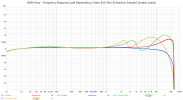That’s a start, though the THD vs Frequency vs Power is very hard to read. All other graphs are not biased to 0 dB, making them also harder to read. He will improve no doubt
-
WANTED: Happy members who like to discuss audio and other topics related to our interest. Desire to learn and share knowledge of science required. There are many reviews of audio hardware and expert members to help answer your questions. Click here to have your audio equipment measured for free!
You are using an out of date browser. It may not display this or other websites correctly.
You should upgrade or use an alternative browser.
You should upgrade or use an alternative browser.
Complex impedance load amp FR influence - WiiM Amp review by Erin
- Thread starter ctrl
- Start date
This is a very poor result, really.However, even with the impedance profiles used with 20 ohm peaks, the benefits of such measurements are evident. In the tested WiiM Amp. A 0.6dB SPL increase is observed in the presence range of 2-4kHz, which can result in an aggressive perceived sound:

Yorkshire Mouth
Major Contributor
This is a very poor result, really.
Compared with…?
Compared to objective reality maybe. On the other hand, find another streamer with similar power, size and features for a comparable price…?Compared with…?
Yorkshire Mouth
Major Contributor
Compared to objective reality maybe. On the other hand, find another streamer with similar power, size and features for a comparable price…?
My point.
Indeed, given usage, this may not be very poor at all.
In some instances, for example with easy to drive speakers at a short listening distance, it may be close to perfect.
I’m being a tad provocative, but I’ll just throw it out there.
Sokel
Master Contributor
- Joined
- Sep 8, 2021
- Messages
- 6,127
- Likes
- 6,204
Random,dependable results will never be close to perfect,in fact it will be far.My point.
Indeed, given usage, this may not be very poor at all.
In some instances, for example with easy to drive speakers at a short listening distance, it may be close to perfect.
I’m being a tad provocative, but I’ll just throw it out there.
There's some things that cutting corners (or cost) cannot be replaced.
Also,specs are suppose to apply to the whole amp and the multitone probably exposes more problems.
The solution about dependency is right there,on @ctrl post or a better amp for overall performance.
grogi.giant
Active Member
- Joined
- Apr 30, 2021
- Messages
- 256
- Likes
- 166
Compared with…?
With any solid state or PFFB-enabled amp.
PFFB is key to acceptable performance in a class-D amp , this gives random results depending on your speaker?With any solid state or PFFB-enabled amp.
And as frequency response deviations are one of the things most audible to humans ?
It’s more important to get this right rather than 0,01% or 0.001% ThD which no one hears .
So it fails where it actually matters most , in a potentially audible part of its performance?
Power and current may very well be good enough for a small setup where no one is playing very loud .
Also would not a correct PFFB also improve many others aspects of the performance like thd ?
grogi.giant
Active Member
- Joined
- Apr 30, 2021
- Messages
- 256
- Likes
- 166
Also would not a correct PFFB also improve many others aspects of the performance like thd ?
PFFB does boost the THD by a few dB all right.
Yorkshire Mouth
Major Contributor
PFFB is key to acceptable performance in a class-D amp , this gives random results depending on your speaker?
And as frequency response deviations are one of the things most audible to humans ?
It’s more important to get this right rather than 0,01% or 0.001% ThD which no one hears .
So it fails where it actually matters most , in a potentially audible part of its performance?
Power and current may very well be good enough for a small setup where no one is playing very loud .
Also would not a correct PFFB also improve many others aspects of the performance like thd ?
Your first sentence says this product is unacceptable. Many would beg to differ.
Both Amir and Erin’s reviews suggest the issues discussed are only really a problem in large rooms/longer seating distances/tough to drive speakers.
Most of the issues are at over 10 kHz. I’m not sure more than half us (the older half) can hear a 1 dB deviation between 10 kHz and 20 kHz.
Sokel
Master Contributor
- Joined
- Sep 8, 2021
- Messages
- 6,127
- Likes
- 6,204
You got the red bold wrong,this has nothing to do with power.Your first sentence says this product is unacceptable. Many would beg to differ.
Both Amir and Erin’s reviews suggest the issues discussed are only really a problem in large rooms/longer seating distances/tough to drive speakers.
Most of the issues are at over 10 kHz. I’m not sure more than half us (the older half) can hear a 1 dB deviation between 10 kHz and 20 kHz.
The "tough to drive" part is also debatable,some of them wouldn't be tough at all with a proper engineered amp.
staticV3
Master Contributor
- Joined
- Aug 29, 2019
- Messages
- 8,013
- Likes
- 12,852
Neither random, nor casually audible at about ±1dB change with usual speaker loads:PFFB is key to acceptable performance in a class-D amp , this gives random results depending on your speaker?
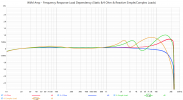
In the face of room acoustics, mastering quality, and unit-to-unit loudspeaker variation, that's meaningless.
So yes, load dependency is not nice from a theoretical standpoint, but it's inconsequential in practice.
D
Deleted member 48726
Guest
It is random as each speaker has different phase/impedance. It is random because it is not safe to say how it will react with each speaker. And yes, with this exact load (Erins complex load test) it results in +/- 1 dB. But had the Zmax been twice as high and at a different frequency? Has it had two impedance peaks in the mid/high frequency range what would the resulting response be?Neither random, nor casually audible at about ±1dB change with usual speaker loads:
View attachment 351008
In the face of room acoustics, mastering quality, and unit-to-unit loudspeaker variation, that's meaningless.
So yes, load dependency is not nice from a theoretical standpoint, but it's inconsequential in practice.
It's not so much the single cases that are bothersome as it is the uncertainty how it will react with my (your) speakers. As such, as we know it can be easily mitigated by design, why don't we strive for that instead of focusing on a combined THD+N value that are waay below audible?
yes 0,5 to 1dB in quite broad range in the direct sound is audible . if it where a very narrow spike not so much .It is random as each speaker has different phase/impedance. It is random because it is not safe to say how it will react with each speaker. And yes, with this exact load (Erins complex load test) it results in +/- 1 dB. But had the Zmax been twice as high and at a different frequency? Has it had two impedance peaks in the mid/high frequency range what would the resulting response be?
It's not so much the single cases that are bothersome as it is the uncertainty how it will react with my (your) speakers. As such, as we know it can be easily mitigated by design, why don't we strive for that instead of focusing on a combined THD+N value that are waay below audible?
Sokel
Master Contributor
- Joined
- Sep 8, 2021
- Messages
- 6,127
- Likes
- 6,204
Use cases can be different and that's the weakness,it's random.
The elephant in the room thought is the difference of multitone vs power measurement where it throws the white towel.
Let's not forget,it's an amp after all.
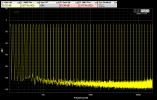
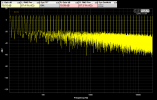
(via Erin's measurements)
The elephant in the room thought is the difference of multitone vs power measurement where it throws the white towel.
Let's not forget,it's an amp after all.


(via Erin's measurements)
morillon
Major Contributor
- Joined
- Apr 19, 2022
- Messages
- 1,382
- Likes
- 279
Your first sentence says this product is unacceptable. Many would beg to differ.
Both Amir and Erin’s reviews suggest the issues discussed are only really a problem in large rooms/longer seating distances/tough to drive speakers.
Most of the issues are at over 10 kHz. I’m not sure more than half us (the older half) can hear a 1 dB deviation between 10 kHz and 20 kHz.
you can see that it concerns much earlier than 10khz on loads closer than reality..
a lot...
;-)
(honestly..if we come across feedback on an often brilliant-hard aspect etc. on this type of amplifier, it is good that it concerns between 2k and 10-12khz..otherwise I won't be so often pointed out)
Attachments
grogi.giant
Active Member
- Joined
- Apr 30, 2021
- Messages
- 256
- Likes
- 166
Neither random, nor casually audible at about ±1dB change with usual speaker loads:
View attachment 351008
In the face of room acoustics, mastering quality, and unit-to-unit loudspeaker variation, that's meaningless.
So yes, load dependency is not nice from a theoretical standpoint, but it's inconsequential in practice.
It's not irrelevant. Sometimes the other aspects will cancel the uneven response, but sometimes they will enforce it. What one should aim for is, where they have control, have neutrality.
The chase for -80dB THD is meaningless, other elements introduce distortion orders of magnitude larger. Speaker response variation is in the same size class, so both - coloration from the amp and coloration from the speaker - will matter.
I was fortunate enough not to notice any coloration caused by TPA325x based amplifiers with my speakers. I did however hear coloration with samples gathered by @pma with his speakers... It is also common for users to express their disappointment with the sound of TPA325x amps + Elac Debut Reference speakers. So that load dependency is not completely irrelevant...
While I can let the $50 product slide, product in $300 class should not have potential to introduce such artifacts. Frankly speaking, I was very disapointed to see the Wiim Amp being released without PFFB implemented...
Last edited:
OP
- Thread Starter
- #39
Most of the issues are at over 10 kHz. I’m not sure more than half us (the older half) can hear a 1 dB deviation between 10 kHz and 20 kHz.
Erin's frequency response measurements with complex load of only 3-20 ohms resulted in deviations of 0.6dB in the presence range of 2-4kHz with the WiiM Amp.
For many speakers, the extremes are much more pronounced. Impedance below 2 ohms and above 60 ohms are quite possible, which could lead to even greater frequency response irregularities below 10kHz.
The perceptibility of 0.5-1 dB frequency response peaks in the presence range of 1-4kHz (especially around 2.5-3.5 kHz) is underestimated by many. When one knows a piece of music well, additional aggressiveness, brightness, and sharpness at certain points are easily noticeable.
Here's an example of a music sample (one could easily find better examples) where the presence range from 2.5 to 3.5 kHz was raised only by 1dB - you can find the flac files (original + modified) as "zipped" attachment.
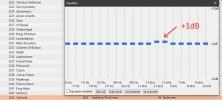

In an ABX test with foobar, I can reliably hear the difference in the first round (without practice) using a $10 headphone.
Attachments
D
Deleted member 48726
Guest
The 1 dB change is quite audible. Specially in the mid-high area. I've fine tuned my Dirac Live curves with less than 1 dB variance over that area and by quickly changing between profiles on the miniDSP it's obvious.
Similar threads
- Replies
- 2
- Views
- 365
- Replies
- 19
- Views
- 1K
- Replies
- 178
- Views
- 9K
- Replies
- 3
- Views
- 360
- Replies
- 775
- Views
- 129K

